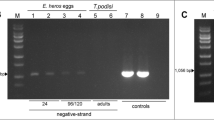Abstract
The control of viral infections, especially those caused by influenza viruses, is of great interest in Public Health. Bio prospection has shown the presence of active principles in the hemolymph of arthropods, and in the salivary gland of ticks, and some of these are of interest for the development of new pharmacological drugs. Ticks lay their eggs in the environment, and to protect them from desiccation and microbial attack they involve the eggs in a waxy layer produced by an organ known as Gené’s Organ. In this study, the eggs wax from tick Amblyomma cajennense (Fabricius) was extracted using ice cold phosphate buffer. The antiviral activity was evaluated with picornavirus and influenza virus. In both cases egg wax was able to inhibit virus replication. For influenza virus, an amount as small as 12 μg/mL of crude egg wax suspension neutralized 128 UHA (hemaglutinant unit) of H1N1 influenza virus. With picornavirus, egg wax led to a 256-fold reduction in virus production by L929 cells. Egg wax was not cytotoxic to VERO, MDCK and L929 cell, being observed that the cell morphology was preserved with concentration as high as 2 mg/mL. In addition no genotoxic effect was observed for Vero cells, suggesting a very interesting potential antiviral activity.





Similar content being viewed by others
References
Arrieta MC, Leskin BK, Kaufman WR (2006) Antimicrobial activity in the egg wax of the African cattle tick Amblyomma hebraeum (Acari: Ixodidae). Exp Appl Acarol 39:297–313
Bulet P (2002) Antiviral and antitumor peptides from insects. Proc Natl Acad Sci USA 99:12628–12632
Bulet P, Hetru C, Dimarcq J, Hoffmann D (1999) Antimicrobial peptides in insects: structure and function. Dev Comp Immunol 23:329–334
Castro JJ (1997) Sustainable tick and tickborne disease control in livestock improvement in developing countries. Vet Parasitol 71:77–97
Esteves E, Fogaça AC, Maldonado R, Silva FD, Manso PPA, Pelajo-Machado M, Valle DS, Daffre S (2009) Antimicrobial activity in the tick Rhipicephalus (Boophilus) microplus eggs: cellular localization and temporal expression of microplusin during oogenesis and embryogenesis. Dev Comp Immunol 33:913–919
Greco KN, Mendonça RMZ, Moraes RHP, Mancini DAP, Mendonça RZ (2009) Antiviral activity of the hemolymph of Lonomia obliqua (Lepidoptera: Saturniidae). Antiviral Res 84:84–90
Griffiths B, Thornton B (1982) Use of microcarrier culture for the production of herpes simplex virus (type 2) in MRC-5 cells. J Chem Technol Biotechnol 32:324–329
Hajnická V, Fuchsberger N, Slovák M, Kokáková P, Labuda M, Nuttall PA (1998) Ticks salivary gland extract promotes virus growth in vitro. Parasitology 116:533–538
Johns R, Sonenshine DE, Hynes WL (1998) Control of bacterial infections in the hard tick Dermacentor variabilis (Acari: Ixodidae): evidence for the existence of antimicrobial proteins in tick haemolymph. J Med Entomol 35:458–464
Jongejan F, Uilenberg G (2004) The global importance of ticks. Parasitology 129:S3–S14
Kokáková P, Hajnická V, Slovák M, Nuttall PA, Fuchsberger N (1999) Promotion of vesicular stomatitis virus nucleocapsin protein production by arthropod saliva. Acta Virol 43:251–254
Kubes M, Fuchsberger N, Labuda M, Zuffová M, Nuttall PA (1994) Salivary gland extracts of partially fed Dermacentor reticulatus ticks decrease natural killer cell activity in vitro. Immunology 82:113–116
Labuda M, Jones LD, Williams T, Nuttall PA (1993) Enhancement of tick-borne encephalitis virus transmission by tick salivary gland extract. Med Vet Entomol 7:193–196
Lai R, Lomas LO, Jonczy J, Turner PC, Rees HH (2004) Two novel non-cationic defensin-like antimicrobial peptides from haemolymph of the female tick, Amblyomma hebraeum. Biochem J 379:681–685
Lima-Netto S, Mendonça RZ, Franzolin MR, Utescher CL, Orozco S, Máximo-Espindola C, Labruna M, Barros-Battesti DM (2011) An interesting antimicrobial activity of egg wax from Amblyomma cajennense (Acari: Ixodidae). Syst Appl Acarol 16:3–6
Marchini D, Giordano PC, Amons R, Bernini LF, Dallai R (1993) Purification and primary structure of ceratotoxin A and B, two antibacterial peptides from the female reproductive accessory glands of the medfly Ceratitis capitata (Insecta:Diptera). Insect Biochem Mol Biol 23:591–598
Mejri N, Rutti B, Brossard M (2002) Immunosuppressive effects of Ixodes ricinus tick saliva or salivary gland extracts on innate and acquired immune response of BALB/c mice. Parasitol Res 88:192–197
Nakajima Y, Ishibashi J, Yukuhiro F, Asaoka A, Taylor D, Yamakawa M (2003) Antibacterial activity and mechanism of action of tick defensin against Gram-positive bacteria. Biochim Biophys Acta 1624:125–130
Petricevich VL, Mendonça RZ (2003) Effect of Crotalus venom on growth of measles virus. Toxicon 42:01–11
Pinter A, Labruna MB, Faccini JLH (2002) The sex ratio of Amblyomma cajennense (Acari: Ixodidae) with notes on the male feeding period in the laboratory. Vet Parasitol 105:79–88
Ravichandran S, Wahidulla S, D’Souza L, Rameshkumar G (2009) Antimicrobial lipids from the hemolymph of brachyuran crabs. Appl Biochem Biotechnol 162(4):1039–1051
Rolníková T, Kazimírová M, Buc M (2003) Modulation of human lymphocyte proliferation by salivary gland extracts of ixodid ticks (Acari: Ixodidae): effect of feeding stage and sex. Folia Parasitol 50:305–312
Savi LA, Barardi CRM, Simões CMO (2006) Evaluation of antiherpetic activity and genotoxic effects of tea catechin derivatives. J Agric Food Chem 54:2552–2557
Shin WJ, Lee KH, Park MH, Seong BL (2010) Broad-spectrum antiviral effect of Agrimonia pilosa extract on influenza viruses. Microbiol Immunol 54:11–19
Singh NP, Mc Coy MT, Tice RR, Schnider EL (1988) A simple technique for quantification of low levels of DNA damage in individual cells. Exp Cell Res 175:184–191
Xu X, Li J, Lu Q, Yang H, Zhang Y, Lai R (2006) Two families of antimicrobial peptides from wasp (Vespa magnifica) venom. Toxicon 47:249–253
Acknowledgments
The authors acknowledge the financial support of FAPESP (2008/57263-5) and CNPq for academic career scholarship to DMBB and RZM.
Author information
Authors and Affiliations
Corresponding author
Rights and permissions
About this article
Cite this article
de Lima-Netto, S., Pinheiro, A., Nakano, E. et al. Antiviral effect of the egg wax of Amblyomma cajennense (Acari: Ixodidae). Cytotechnology 64, 601–606 (2012). https://doi.org/10.1007/s10616-012-9444-3
Received:
Accepted:
Published:
Issue Date:
DOI: https://doi.org/10.1007/s10616-012-9444-3




